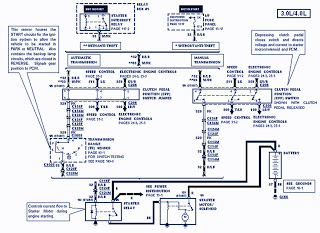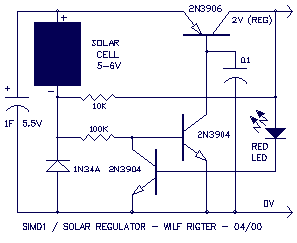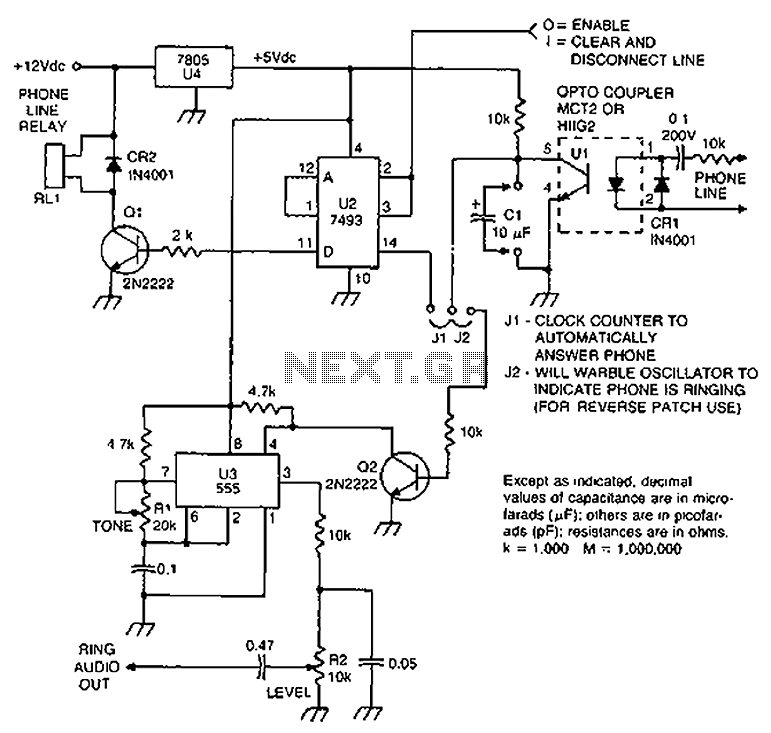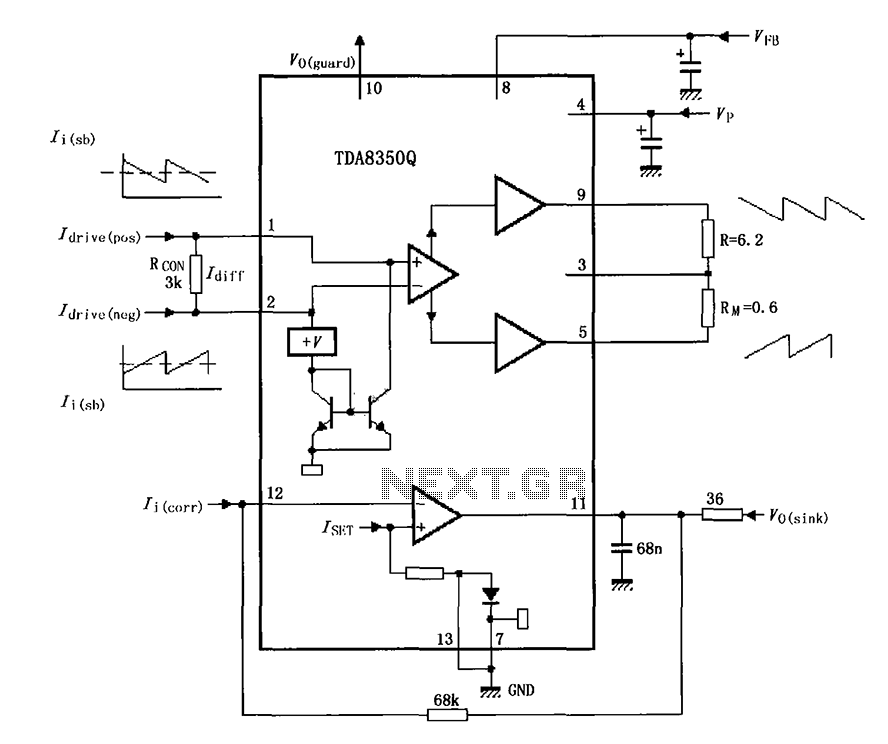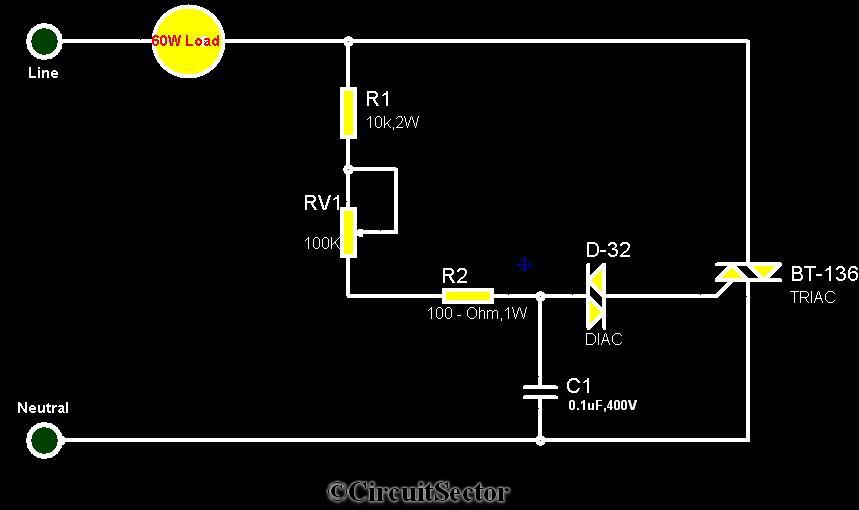
Micropower Voltage Regulator Schematic Diagram

This circuit is designed to power an AVR microcontroller from a 12V lead-acid battery. The watchdog component consumes only 14 µA. While integrated circuits (ICs) from manufacturers like Linear Technology or Maxim can be utilized for this purpose, they are often difficult to obtain and primarily available in surface mount device (SMD) packages. These challenges can be effectively addressed using this discrete circuit. The primary control element is the commonly available BS170 FET. When power is applied, it is activated through resistor R1. Once the output voltage reaches 5.1V, transistor T2 begins to conduct, limiting further increases in output voltage by lowering the gate voltage of T1. The output voltage can be calculated using the following parameters: ULED is 1.6V and UBE is 0.5V. The temperature coefficients of ULED and UBE can also be included in the calculation. The simplicity of the circuit suggests that it has likely been conceived by others before. The author's design is reminiscent of a reference circuit from 1967, which employed germanium transistors and did not use a FET. In that earlier design, the voltage reference was a Zener diode, and it was engineered to handle currents of up to 10A. It is possible that there are even older examples of two-transistor regulators that follow this principle.
The circuit operates by utilizing a discrete design to regulate voltage for an AVR microcontroller, ensuring reliable operation from a 12V lead-acid battery. The BS170 FET serves as the primary switching element, controlled by resistor R1, which helps to manage the gate voltage and, consequently, the output voltage. The circuit’s design is straightforward, allowing for easy assembly and troubleshooting.
The output voltage regulation is achieved through the interaction between T1 and T2, where T2 acts to stabilize the output once it reaches the predetermined threshold of 5.1V. This feedback mechanism is essential for maintaining a consistent voltage supply to the microcontroller, preventing potential damage from voltage spikes.
The calculation of the output voltage takes into account the forward voltage drop across the LED (ULED) and the base-emitter voltage drop of the transistor (UBE). By incorporating the temperature coefficients of these components, the circuit can be fine-tuned for optimal performance across varying conditions.
This design is particularly advantageous in environments where sourcing specific ICs may be challenging, as it relies on widely available discrete components. Its historical context, linked to earlier designs, underscores the enduring principles of voltage regulation while adapting them to contemporary needs. Overall, this circuit exemplifies a practical approach to power regulation in microcontroller applications, with a focus on accessibility and reliability.This circuit was industrial to power an AVR microcontroller from a 12 opposed to run-acid battery. The watchdog itself draws solitary 14 µA. Of avenue, at hand are dyed-in-the-wool ICs, in lieu of model from Linear machinery or else Maxim, which can subsist used, but these can be very brutally to pick up grasp of and are commonly barely to be had during SMD letters these days. These difficulties are simply and quickly avoided using this discrete circuit. The succession control device factor is the widely-presented type BS170 FET. whilst power is useful it is driven on via R1. When the output voltage reaches 5. 1 opposed to, T2 starts to conduct and limits some advance gradient stylish the output voltage by pulling down the voltage on the gate of T1. The output voltage can be present calculated seeing that follows: Anywhere we can agreed ULED by 1. 6 in opposition to and UBE at 0. 5 V. The warmth coefficients of ULED and UBE can moreover be incorporated into the formula. The circuit is so effortless with the intention of of line someone has thinking of it ahead of. The author`s hard work control bowed up an illustration appearing in a collection of reference circuits dating from 1967: the example is very alike to this circuit, although it used germanium transistors and of choice here was refusal FET.
The voltage reference was a Zener diode, and the circuit was designed used for currents of up to 10 A. Perhaps our readers pray be there able to unearth even earlier examples of two-transistor regulators using this belief You are reading the Circuits of Micropower Voltage Regulator And this circuit permalink url it is
🔗 External reference
The circuit operates by utilizing a discrete design to regulate voltage for an AVR microcontroller, ensuring reliable operation from a 12V lead-acid battery. The BS170 FET serves as the primary switching element, controlled by resistor R1, which helps to manage the gate voltage and, consequently, the output voltage. The circuit’s design is straightforward, allowing for easy assembly and troubleshooting.
The output voltage regulation is achieved through the interaction between T1 and T2, where T2 acts to stabilize the output once it reaches the predetermined threshold of 5.1V. This feedback mechanism is essential for maintaining a consistent voltage supply to the microcontroller, preventing potential damage from voltage spikes.
The calculation of the output voltage takes into account the forward voltage drop across the LED (ULED) and the base-emitter voltage drop of the transistor (UBE). By incorporating the temperature coefficients of these components, the circuit can be fine-tuned for optimal performance across varying conditions.
This design is particularly advantageous in environments where sourcing specific ICs may be challenging, as it relies on widely available discrete components. Its historical context, linked to earlier designs, underscores the enduring principles of voltage regulation while adapting them to contemporary needs. Overall, this circuit exemplifies a practical approach to power regulation in microcontroller applications, with a focus on accessibility and reliability.This circuit was industrial to power an AVR microcontroller from a 12 opposed to run-acid battery. The watchdog itself draws solitary 14 µA. Of avenue, at hand are dyed-in-the-wool ICs, in lieu of model from Linear machinery or else Maxim, which can subsist used, but these can be very brutally to pick up grasp of and are commonly barely to be had during SMD letters these days. These difficulties are simply and quickly avoided using this discrete circuit. The succession control device factor is the widely-presented type BS170 FET. whilst power is useful it is driven on via R1. When the output voltage reaches 5. 1 opposed to, T2 starts to conduct and limits some advance gradient stylish the output voltage by pulling down the voltage on the gate of T1. The output voltage can be present calculated seeing that follows: Anywhere we can agreed ULED by 1. 6 in opposition to and UBE at 0. 5 V. The warmth coefficients of ULED and UBE can moreover be incorporated into the formula. The circuit is so effortless with the intention of of line someone has thinking of it ahead of. The author`s hard work control bowed up an illustration appearing in a collection of reference circuits dating from 1967: the example is very alike to this circuit, although it used germanium transistors and of choice here was refusal FET.
The voltage reference was a Zener diode, and the circuit was designed used for currents of up to 10 A. Perhaps our readers pray be there able to unearth even earlier examples of two-transistor regulators using this belief You are reading the Circuits of Micropower Voltage Regulator And this circuit permalink url it is
🔗 External reference

